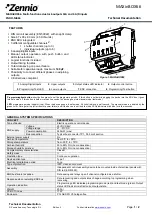
AKD 5000
Special
functions
less than 1.6 Hz. Choose a suitable time constant in
parameter 444,
Process PID Lowpass filter
.
Optimisation of the process controller
The basic settings have now been made; all that needs
to be done is to optimise the proportional gain, the
integration time and the differentiation time (parameters
440, 441, 442). In most processes, this can be done
by following the guidelines given below.
1. Start the motor
2. Set parameter 440 (proportional gain) to 0.3 and
increase it until the feedback signal again begins
to vary continuously. Then reduce the value until
the feedback signal has stabilised. Now lower
the proportional gain by 40-60%.
3. Set parameter 441 (integration time) to 20s
and reduce the value until the feedback signal
again begins to vary continuously. Increase the
integration time until the feedback signal stabilises,
followed by an increase of 15-50%.
4. Only use parameter 442 for very fast-acting
systems only (differentiation time). The typical
value is four times the set integration time. The
differentiator should only be used when the
setting of the proportional gain and the integration
time has been fully optimised.
NB!:
If necessary, start/stop can be activated
a number of times in order to provoke a
variation of the feedback signal.
See also the examples of connection given
in the Design Guide.
■
Quick discharge
This function calls for a frequency converter of type EB.
This function is used for discharging the capacitors
in the intermediate circuit after the mains supply
has been interrupted. This is a useful function for
servicing the frequency converter and/or the motor
installation. The motor must be stopped before
quick discharge is activated. If the motor acts as a
generator, quick discharge is not possible.
The quick discharge function can be selected
via parameter 408. The function starts when the
intermediate circuit voltage has dropped to a given
value and the rectifier has stopped.
In order to obtain the possibility of a quick discharge,
the frequency converter requires an external 24 V DC
supply to terminals 35 and 36, as well as a suitable
brake resistor on terminals 81 and 82.
For sizing of the discharge resistor for quick discharge,
see Brake Instructions MI.50.DX.XX.
NB!:
Quick discharge is only possible if the
frequency converter has 24 Volts external
DC supply and if an external brake/discharge
resistor has been connected.
Before servicing the installation (frequency
con motor), it must be checked
that the intermediate circuit voltage
is below 60 V DC. This is done by measuring
terminals 88 and 89, load-sharing.
NB!:
The power dissipation during quick discharge
does not form part of the power monitoring
function, parameter 403. When sizing resistors,
this fact should be taken into consideration.
175ZA447.10
Quick discharge
activated
Check 24 Volts
external DC supply
TRIP (RESET)
Q.DISCHARGING FAILED
No 24 Volts external
DC supply
Q.DISCHARGING FAILED
Timeout
Parameter 408 = [1]
Discharge
Discharge completed
POWER IS DISCHARGED
TRIP (RESET)
ALARM:33
ALARM:33
24 Volts external
DC supply OK
Start
Quick discharge
■
Mains failure/quick discharge with mains
failure inverse
The first column in the table shows
Mains failure
,
which is selected in parameter 407. If no function
is selected, the mains failure procedure will not be
carried out. If
Controlled ramp-down
[1] is selected,
the frequency converter will take the motor down to 0
Hz. If
Enable
[1] has been selected in parameter 408,
MG.50.R3.02 -
55
















































